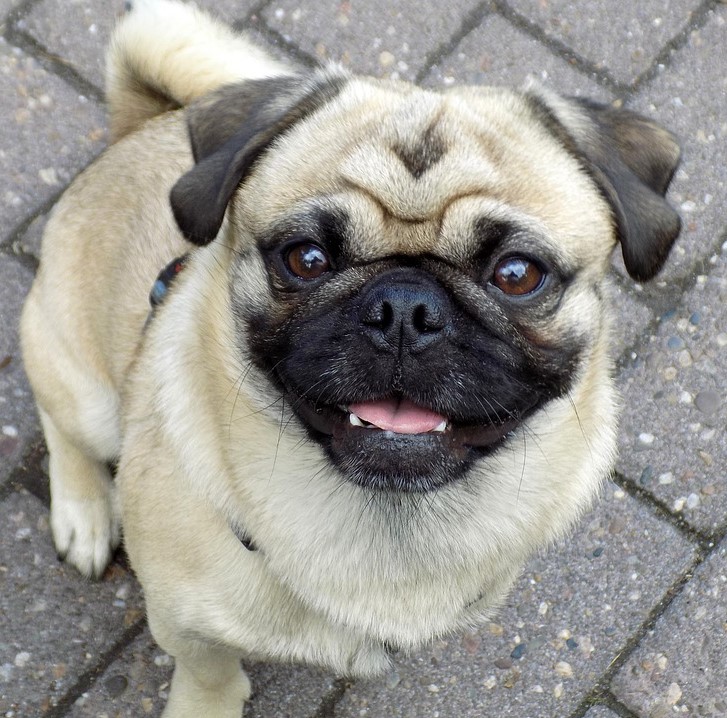Breed Conformation and Welfare Issues
FECAVA International Resources:
Healthy Breeding: Brachycephalic issues: shared resources
Ocular Syndrome
- Universities Federation for Animal Welfare (UFAW) - https://www.ufaw.org.uk/dogs/pug-brachycephalic-ocular-syndrome
BOAS
- Pug Health UK - https://www.pughealth.org.uk/boas/
Hemivertebrae in Pugs
- Universities Federation for Animal Welfare (UFAW) - https://www.ufaw.org.uk/dogs/pug-hemivertebrae
The Evolution of Petface
- Smithsonian Magazine - https://www.smithsonianmag.com/science-nature/evolution-petface-180967987/
Pug Myelopathy References
Pug_Myelopathy_References final 04.28.21_Smiler.docx
The document contains references to research on French Bulldogs as well as Pugs.
The Kennel Club and University of Cambridge's Respiratory Function Grading Scheme
UK:KC: Pugs: Category 3 Breed Watch
Points of concern for special attention by judges
- Dogs showing respiratory distress including difficulty in breathing or laboured breathing
- Excessive nasal folds
- Excessively prominent eyes
- Hair loss or scarring from previous dermatitis
- Incomplete blink
- Pinched nostrils
- Significantly overweight
- Signs of dermatitis in skin folds
- Sore eyes due to damage or poor eyelid conformation
- Unsound movement
Sweden: SKK: Breed Specific Instructions: BSI
Pug – brachycephalic and small molossoïd breed
Areas of risk are:
1. Breathing problems: Forced breathing with pronounced snoring sounds due to short muzzle, pinched nostrils, narrow respiratory channels (insufficient room in pharyngeal cavities and airways) and/or short and open rib cage with short ribs and sternal bone. Obesity/overweight. See Appendix 2.
2. Face: Overly short muzzle with improper dentition, excessive loose skin, and hair on a nose wrinkle disturbing the function of the eyes as well as the nose. The standard does in fact not ask for a nose wrinkle – neither unbroken nor broken.
3. Eyes: Protruding eyes, which increase the risk of eye injuries. See Appendix 3.
Look for sound breathing, sound skin and eyes, the formation of the rib cage, and the size and weight. The standard mentions the ideal weight to be 6,3-8,1 kg. The standard calls for: “Muzzle: relatively short”
BSI - Nordic Kennel Clubs 2018 (second edition)
France (SCC)
-
The French Kennel Club BREATH Test Protocol for Brachycephalic Breeds
-
See SCC's website for more information/test schedule: https://www.centrale-canine.fr/lofselect/articles/test-breath-pour-les-races-brachycephales
DWN Articles and Blogs
Videos
RESEARCH
O’Neill, D.G., Sahota, J., Brodbelt, D.C. et al. Health of Pug dogs in the UK: disorder predispositions and protections. Canine Med Genet 9, 4 (2022). https://doi.org/10.1186/s40575-022-00117-6
De Decker, S., Packer, R., Cappello, R., Harcourt-Brown, T. R., Rohdin, C., Gomes, S. A., Bergknut, N., Shaw, T. A., Lowrie, M., & Gutierrez-Quintana, R. (2019). Comparison of signalment and computed tomography findings in French Bulldogs, Pugs, and English Bulldogs with and without clinical signs associated with thoracic hemivertebra. Journal of veterinary internal medicine, 33(5), 2151–2159. https://doi.org/10.1111/jvim.15556
O’Neill, D.G., Darwent, E.C., Church, D.B. et al. Demography and health of Pugs under primary veterinary care in England. Canine Genet Epidemiol 3, 5 (2016). https://doi.org/10.1186/s40575-016-0035-z
Pegram et al. (2021) “Frequency, breed predisposition and demographic risk factors for overweight status in dogs in the UK” Journal of Small Animal Practice. DOI: 10.1111/jsap.13325. https://onlinelibrary.wiley.com/doi/10.1111/jsap.13325
Dan G O'Neill, Aoife M O'Sullivan, Erin A Manson, David B Church, Paul D McGreevy, Amanda K Boag, Dave C Brodbelt, Canine dystocia in 50 UK first‐opinion emergency care veterinary practices: clinical management and outcomes, Veterinary Record, 10.1136/vr.104944, 184, 13, (409-409), (2019). https://bvajournals.onlinelibrary.wiley.com/doi/abs/10.1136/vr.104108
O’Neill, D.G., Pegram, C., Crocker, P. et al. Unravelling the health status of brachycephalic dogs in the UK using multivariable analysis. Sci Rep 10, 17251 (2020). https://doi.org/10.1038/s41598-020-73088-y
Great expectations, inconvenient truths, and the paradoxes of the dog-owner relationship for owners of brachycephalic dogs
Packer RMA, O’Neill DG, Fletcher F, Farnworth MJ (2019) Great expectations, inconvenient truths, and the paradoxes of the dog-owner relationship for owners of brachycephalic dogs. PLOS ONE 14(7): e0219918. https://doi.org/10.1371/journal.pone.0219918
Rohdin, C., Jäderlund, K.H., Ljungvall, I., Lindblad-Toh, K. and Häggström, J. (2018), High prevalence of gait abnormalities in pugs. Veterinary Record, 182: 167-167. https://doi.org/10.1136/vr.104510 https://bvajournals.onlinelibrary.wiley.com/doi/full/10.1136/vr.104510
ONGOING Research
Pug Dog Club of America: Pug Dog Encephalitis (PDE) Genetics Research Project - University of Georgia College of Veterinary Medicine
See more ongoing Research info at PDCA: https://www.pugdogclubofamerica.com/pug-health-research.html


Recommended Comments
Please sign in to comment
You will be able to leave a comment after signing in
Sign In Now